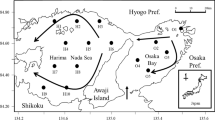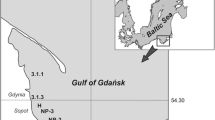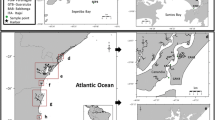Abstract
The concentrations of butyltins (BTs) in sediment from Peninsular Malaysia along the Strait of Malacca and their spatial distribution are discussed. The concentrations of BTs were high in the southern part of Peninsular Malaysia where there is a lot of ship traffic, because trade is prosperous. The concentrations of monobutyltin (MBT), dibutyltin (DBT), and tributyltin (TBT) in sediment from the coastal waters of Peninsular Malaysia were in the range 4.1–242 μg/kg dry weight (dw), 1.1–186 μg/kg dw, and 0.7–228 μg/kg dw, respectively. A higher percentage of TBT was observed in the area where TBT concentrations were high. The concentrations of monophenyltin (MPT), diphenyltin (DPT), and triphenyltin (TPT) were in the range <0.1–121 μg/kg dw, 0.4–27 μg/kg dw, and 0.1–34 μg/kg dw in sediment from Peninsular Malaysia, respectively. MPT was the dominant phenyltin species. MBT, DBT, and TBT in green mussel (Perna viridis) samples were detected in the range 41–102 μg/kg, 3–5 μg/kg, and 8–32 μg/kg, respectively. A tolerable average residue level (TARL) was estimated at 20.4 μg/kg from a tolerable daily intake (TDI) of 0.25 μg TBTO/kg body weight/day. The maximum value of TBT detected in green mussel samples was the value near the TARL. TPTs were not detected in green mussel samples. The concentrations of Diuron and Irgarol 1051 in sediment from Peninsular Malaysia were in the range <0.1–5 μg/kg dw and <0.1–14 μg/kg dw, respectively. High concentrations of these compounds were observed in locations where the concentrations of TBT were high. Sea Nine 211, Dichlofluanid, and Pyrithiones were not detected in sediment. The concentrations of antifouling biocides in Melaka and the Strait of Johor were investigated in detail. BTs were found in similar concentrations among all sampling sites from Melaka, indicating that BT contamination spread off the coast. However, Sea Nine 211, Diuron, and Irgarol 1051 in the sediment from Melaka were high at the mouth of the river. BT concentrations at the Strait of Johor were higher than those in Peninsular Malaysia and Melaka and were high at the narrowest locations with poor flushing of water. The concentrations of antifouling biocides were compared among Malaysia, Thailand, and Vietnam. A higher concentration and wide variations of TBT and TPT in sediment from Malaysia were observed among these countries. The Irgarol 1051 concentrations in sediment from Malaysia were higher than those in Thailand and Vietnam.








Similar content being viewed by others
References
Belfroid AC, Purperhart M, Ariese F (2000) Organotin levels in seafood. Marine Pollut Bull 40:226–232. doi:10.1016/S0025-326X(99)00241-6
Biselli S, Bester K, Huhnerfuss H, Fent K (2000) Concentrations of the antifouling compound Irgarol 1051 and of organotins in water and sediments of German North and Baltic Sea Marine. Marine Pollut Bull 40:233–244. doi:10.1016/S0025-326X(99)00177-0
Boxall ABA, Comber SD, Conrad AU, HJowcroft J, Zaman N (2000) Input monitoring and fate modeling of antifouling biocides in UK estuaries. Marine Pollut Bull 40:898–905. doi:10.1016/S0025-326X(00)00021-7
Bryan GW, Gibbs PE (1991) Impact of low concentrations of tributyltin (TBT) on marine organisms: review. In: Newman MC, McIntosh AW (eds) Metal ecotoxicology: concepts and applications, Lewis Publishers, Ann Arbor, MI, pp 323–361
Clark EA, Sterritt RM, Lester JN (1988) The fate of tributyltin in the aquatic environment. Environ Sci Technol 22:600–604. doi:10.1021/es00171a001
Dowson PH, Bubb JM, Williams TP, Lester JN (1993) Degradation of tributyltin in sediment in freshwater and estuarine marina sediments. Water Sci Technol 28:133–137
Gough MA, Fothergill G, Hendrie JD (1994) Survey of southern England coastal waters for the s-Triazine antifouling compound Irgarol 1051. Marine Pollut Bull 28:613–620. doi:10.1016/0025-326X(94)90363-8
Harino H, Fukushima M, Kawai S, Megumi K (1998) Measurement of butyltin contamination of water and sediment in Osaka Bay, Japan. Appl Organomet Chem 12:819–825. doi:10.1002/(SICI)1099-0739(199812)12:12<819::AID-AOC788>3.0.CO;2-H
Harino H, Mori Y, Yamaguchi Y, Shibata K, Senda T (2005) Monitoring of antifouling booster biocides in water and sediment from the port of Osaka, Japan. Arch Environ Contam Toxicol 48:303–310. doi:10.1007/s00244-004-0084-2
Harino H, Ohji M, Wattayakorn G, Arai T, Rungsupa S, Miyazaki N (2006a) Occurrence of antifouling biocides in sediment and green mussels from Thailand. Arch Environ Contam Toxicol 51:400–407. doi:10.1007/s00244-005-0246-x
Harino H, Midorikawa S, Arai T, Ohji M, Cu ND, Miyazaki N (2006b) Concentrations of booster biocides in sediment and clams from Vietnam. J Marine Biol Assoc UK 86:1163–1170. doi:10.1017/S0025315406014147
Hashimoto S, Watanabe M, Noda Y, Hayashi T, Kurita Y, Takasu Y, Otsuki A (1998) Concentration and distribution of butyltin compounds in a heavy tanker route in the Strait of Malacca and in Tokyo Bay. Marine Environ Res 45:169–177. doi:10.1016/S0141-1136(97)00031-7
Kan-atireklap S, Tanabe S, Sanguansin J (1997a) Contamination by butyltin compounds in sediments from Thailand. Marine Pollut Bull 34:894–899. doi:10.1016/S0025-326X(97)00053-2
Kan-atireklap S, Tanabe S, Sanguanisin J, Tabucanon MS, Hungspreugs M (1997b) Contamination by butyltin compounds and organochlorine residues in green mussel (Perna viridis, L.) from Thailand coastal waters. Environ Pollut 97:79–89. doi:10.1016/S0269-7491(97)00070-5
Kan-atireklap S, Yen NTH, Tanabe S, Subramanian AN (1998) Butyltin compounds and organochlorine residues in green mussel (Perna viridis L.) from India. Environ Toxicol Chem 67:409–424. doi:10.1080/02772249809358631
Kannan K, Lee RF (1996) Triphenyltin and its degradation products in foliage and soils from sprayed pecan orchards and in fish from adjacent ponds. Environ Toxicol Chem 15:1492–1499. doi:10.1897/1551-5028(1996)015<1492:TAIDPI>2.3.CO;2
Laughlin RB Jr, Linden O (1985) Fate and effects of organotin compounds. AMBIO 14:88–94
Lee DB, Prudente MS, Tanabe S, Tatsukawa R (1997) Organochlorine residues in soils and sediments from Manila and nearby provinces, Philippines. Toxicol Environ Chem 60:171–181. doi:10.1080/02772249709358462
Maguire RJ, Tkacz RJ (1985) Degradation of the tri-n-butyltin species in water and sediment from Tronto harbour. J Agric Food Chem 33:947–953. doi:10.1021/jf00065a043
Midorikawa S, Arai T, Harino H, Ohji M, Duc Cu N, Miyazaki, N (2004) Concentrations of orgnotin compounds in sediment and clams collected from coastal areas in Vietnam. Environ Pollut 131:401–408. doi:10.1016/j.envpol.2004.03.007
Monirith I, Ueno D, Takahashi S, Nakata H, Sudaryanto A, Subramarian A, Karuppiah S, Ismail A, Mushtar M, Zheng J, Richardson BJ, Prudente M, Hue ND, Tana TS, Tkalin AV, Tanabe S (2003) Asia-Pacific mussel watch: monitoring contamination of persistant organochlorine conpounds in coastal waters of Asian countries. Marine Pollut Bull 46:281–300. doi:10.1016/S0025-326X(02)00400-9
Penninks AH (1993) The evaluation of data-derived safety factors for bis (tri-n-butyltin) oxide. Food Addit Contam 10:351–361
Prudente M, Ichihashi H, Kan-atireklap S, Watanabe I, Tanabe S (1999) Butyltins, organochlorines and metal levels in green mussel, Perna viridis L. from the coastal waters of the Philippines. Fish Sci 65:441–447
Short JW, Sharp JL (1989) Tributyltin in bay mussel (Mytilus edulis) of the Pacific coast of the United States. Environ Sci Technol 23:740–743. doi:10.1021/es00064a014
Sudaryanto A, Takahashi S, Monirith I, Ismail A, Muchtar M, Zheng J, Richardson BJ, Subramanian A, Prudente M, Hue ND, Tanabe S (2002) Asia-Pacific mussel watch: monitoring of butyltin contamination in coastal waters of Asian developing countries. Environ Toxicol Chem 21:2119–2130. doi:10.1897/1551-5028(2002)021<2119:APMWMO>2.0.CO;2
Sudaryanto A, Takahashi S, Iwata H, Tanabe S, Ismail A (2004) Contamination of butyltin compounds in Malaysian marine environment. Marine Pollut Bull 130:347–358
Thomas K, Blake SJ, Waldock MJ (2000) Antifouling paint booster biocide contamination in UK marine sediment. Marine Pollut Bull 40:739–745. doi:10.1016/S0025-326X(00)00010-2
Thomas K, McHugh M, Waldock M (2002) Antifouling paint booster biocides in UK coastal waters: inputs, occurrence and environmental fate. Sci Total Environ 293:117–127. doi:10.1016/S0048-9697(01)01153-6
Tong SL, Pang FY, Phang SM, Lai HC (1996) Tributyltin distribution in the coastal environment of Peninsular Malaysia. Environ Pollut 91:209–216. doi:10.1016/0269-7491(95)00048-8
Toth S, Becker-van Slooten K, Spack L, de Alencastro LF, Tarradellas J (1996) Irgarol 1051, an antifouling compound in freshwater, sediment and biota of Lake Geneva. Bull Environ Contam Toxicol 57:426–433. doi:10.1007/s001289900208
Acknowledgment
The authors thank Professor Hideshige Takada and his group at the Tokyo University of Agriculture and Technology for assistance with the sampling in Malaysia.
Author information
Authors and Affiliations
Corresponding author
Rights and permissions
About this article
Cite this article
Harino, H., Arai, T., Ohji, M. et al. Contamination Profiles of Antifouling Biocides in Selected Coastal Regions of Malaysia. Arch Environ Contam Toxicol 56, 468–478 (2009). https://doi.org/10.1007/s00244-008-9252-0
Received:
Accepted:
Published:
Issue Date:
DOI: https://doi.org/10.1007/s00244-008-9252-0




